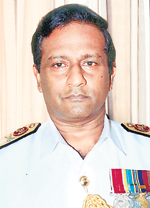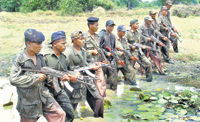 |
|||||||||
| |
|||||||||
|
Clarification or confusion? Last week's Situation Report in The Sunday Times has drawn the attention of the Commander of the Army Lt. Gen. Sarath Fonseka, now undergoing treatment in a Singapore hospital. This is for the injuries he sustained when a suicide bomber successfully infiltrated Army Headquarters on April 25 and exploded herself causing serious injuries to him.
Writing to The Sunday Times on his behalf, the head of the Army Media, Brigadier Prasad Samarasinghe, states in a letter titled "CLARIFICATION ON THE 'SITUATION REPORT' IN THE SUNDAY TIMES OF 9. 07. 2006": "I, on the instruction of Commander of the Army, Lieutenant General Sarath Fonseka, wish to draw your kind attention to certain information published in the 'Situation Report' in The Sunday Times on 9th July 2006. "The particular report carries the news of a woman operative from a State Intelligence Agency who entered the Army Headquarters with two mangoes hidden in her brassier (sic) without being properly checked. It further denotes that a subsequent report on the incident was sent to the Commander of the Army, Navy and Air Force. Commander of the Army denies the receipt of such intelligence report. "He also instructs me to inform that no officer who was forcibly sent on retirement on serious disciplinary grounds has been unofficially given the responsibility of looking after security inside AHQ. It was Colonel S. Sooriyabandara who served as Senior Security Co-ordinator at Army Headquarters. However, since he took over a higher appointment, he was replaced by ……………………….. who holds a good career record in the Army. "Commander of the Army hereby requests that the same publicity be given to the above in your next publication please." Iqbal Athas comments: Firstly, the "clarification" on behalf of the Commander of the Army, Lt. Gen. Sarath Fonseka by the head of the Directorate of Army Media, Brigadier Prasad Samarasinghe has exposed the name of an officer who is now Security Co-ordinator at Army Headquarters. That is the officer who is also responsible for the Army Commander's security within AHQ. Whether this is at the express request of Lt. Gen. Fonseka or by Brigadier Samarasinghe is not clear. But we at The Sunday Times, however, have used our discretion to delete that reference. We believe that is not only official confirmation to the Liberation Tigers of Tamil Eelam (LTTE) the identity of the officer who is now in charge of security within AHQ and for the Commander but will also place the life of this officer, whom Brig. Samarasinghe asserts, has "a good career record" in the Army at great risk. The first complaint of Lt. Gen.Fonseka, according to the "clarification," refers to "the news of a woman operative from a State Intelligence Agency who entered Army Headquarters without being properly checked". It adds: "It further denotes that a subsequent report on the incident was sent to the Commander of the Army, Navy and Air Force. Commander of the Army denies the receipt of such intelligence report." For reasons of clarity and to refresh the minds of The Sunday Times readers, this is what was said in the Situation Report of July 9: "….they forwarded reports on the female intelligence operative's findings together with their observations to Lt. Gen. Fonseka. Copies were also sent to Commanders of the Navy and Air Force. This was intended to help them take preventive measures. Evidently not much had been done at Army Headquarters." Here are more facts now. The female operative from the state intelligence agency concerned walked through the main entrance to Army Headquarters with a mango each in the cups of her bra in the first week of November, last year. Thereafter, on November 28, 2005 representatives of all state intelligence services met at a secret location. The purpose was to review security threats to Colombo and suburbs. That included representatives of the intelligence arms of the three armed forces. They were required to make notes and observations and convey them to their higher command. A specific subject of discussion was the threat on Army Headquarters. There was a warning of that Liberation Tigers of Tamil Eelam (LTTE) cadre gaining access to Army Headquarters using a forged identity card. It was noted that such a person would have access to Army Hospital. One would have expected the participant of the Army intelligence arm to have briefed his superiors and vigorously pursued follow up action. If this was not done, it was bad enough. Worst still is another grim reality. A record of the threat was indeed sent to the Commander of the Army. The Sunday Times confirmed this from sources in the armed forces intelligence services who took part in the discussion. Had action been taken during this period, the incident on April 25 this year, which injured the Army Commander and killed 11 others including his escorts, could have been prevented. Brigadier Samarasinghe's "clarification" on behalf of Lt. Gen. Fonseka is even more damning. By his own admission Lt. Gen. Fonseka had not received the report, not seen it nor heard about it. This only confirms, to say the least, the lack of seriousness over intelligence warnings. Little wonder the LTTE has been successful in conducting surveillance and gathering intelligence for a long period to infiltrate the Army Headquarters.
What followed is history. The "clarification" also claims "no officer who was forcibly sent on retirement on serious disciplinary grounds has been unofficially given the responsibility of looking after security inside AHQ." Here again, for reasons of clarity, the relevant paragraph says "….an officer forcibly retired on serious disciplinary grounds has been unofficially given the responsibility of looking after some of the security inside AHQ. Serving senior officers are worried he was giving some of the orders but are helpless…." I have not said anything about Lt. Gen. Fonseka giving an officer forcibly sent on retirement the responsibility of unofficially looking after security inside AHQ. For that matter, I have not identified as to who has given that responsibility. If Lt. Gen. Fonseka is not aware how this has come about, this also raises serious questions of security within AHQ. Who was responsible for the involvement of an officer forced to retire on disciplinary grounds? But the fact that this officer, whose retirement has been published in the Gazette, was gaining access to AHQ is on record. All one has to do is to check with the Military Police. The Sunday Times supervises security arrangements even as late as last Tuesday. After the revelation in The Sunday Times, a Defence Ministry official had directed the acting Commander of the Army Major General Nanda Mallawaratchchi to immediately stop him from gaining entry into AHQ. That is not all. He had also been told to withdraw the car issued to the officer concerned. However, legal consultations were under way after it was pointed out that the officer concerned had gone to Courts. Legal advice was being sought particularly on the officer's retention of an official Army car.
Home guards to the fore
Rear Admiral Sarath Weerasekera who was appointed Director General of the 30,000 strong Home Guard Force (HGF) in April this year has taken measures to recruit, train, equip and deploy additional home guards in areas vulnerable to LTTE attacks, particularly after the Kebitigollewa bus massacre. In an interview with The Sunday Times, he spoke on the importance of protecting the villagers and said the bunker line to protect them would become a reality in the coming weeks. Excerpts: Q:What is the background to the creation of the home guard unit? A:The unit was created in 1985 to protect villages from LTTE attacks because at that time the army was unable to guard every village. The government gave weapons to selected youth in each village. Initially there was no payment involved neither did they have uniforms. Gradually the demand for their services grew and they were paid and were also given uniforms. Q: Can you comment on your appointment as the Director General of the Home Guard Force? A:After the ceasefire agreement when the situation was relatively peaceful, the importance of the home guard unit decreased and these people found other jobs. This year with the escalation in violence, villages are once again facing the threat of LTTE attacks. In the light of this the government wanted to re-organise the Home Guard Force. I was appointed in April by the President as DG in addition to my duties as the Deputy Chief of Staff of the Navy. Q: What have been your main tasks since taking up this appointment? A:During the first week, I did a study of more than 400 villages that are under threat, the exact number of home guards deployed in each village and also the minimum number required to protect each village in keeping with the recommendations of the army. I also recruited 5000 people from the affected areas. They underwent a two week training programme at Army and Special Task Force (STF) camps before being deployed.
Q: On what basis were they deployed? A:They were deployed according to specifications of the Army and the STF .We have also begun issuing weapons to selected civilians on the recommendation of the police. This is meant as a deterrent against attacks on the homes of villagers. Q: What kind of training has been given to the home guards? A:They have been trained in the use of T- 56 automatic rifles, shot guns and repeater guns. They have also been given training in field craft and the general law. But the training doesn’t stop there. There are training teams that will visit each village regularly to continue training them as well as motivating them. Q: What are the most vulnerable areas? A:The Ampara district, parts of Moneragala, Trincomalee, Kantalai, Vavuniya and parts of Anuradhapura, Polonnaruwa and Puttlam. This is the threatened belt. Q: Since the Kebitigollewa tragedy, the villagers are refusing to return to their homes till the bunker line is put in place to secure their villages. Can you comment? A:These villagers need not be afraid to return to their homes once the Forward Defence Line (FDL) is established in the coming weeks. The work on the bunker line will also start very soon. Q: How bad is the threat to the areas excluding Kebitigollewa? A:I believe the situation is now under control. The required number of men will be trained and deployed in the villages and it will be their responsibility to protect the villagers. We have selected youth from their own villages because when they have to protect their own kith and kin they would do a better job than a person from outside. It is the responsibility of the army and the STF to supervise them. Responsible residents in the village including priests, retired teachers should also be vigilant of their activities and report to me if there are any lapses on the part of the home guards.
A:I believe it is important as these threatened villages are a major component of the national security. If these villagers leave their homes and head south it could destabilise the whole country. So these villages have to be protected and the Home Guard Force is there to do just that. This is why the unit must be further strengthened. It is also the responsibility of every citizen in the country to ensure the security of these people by way of contributing in whatever way they can. Q: Any future plans for the Home Guard Unit? A: I think the government has plans to make it a permanent force. Now it is an auxiliary force . |
|||||||||
Copyright © 2001 Wijeya Newspapers
Ltd. All rights reserved. |
|||||||||



